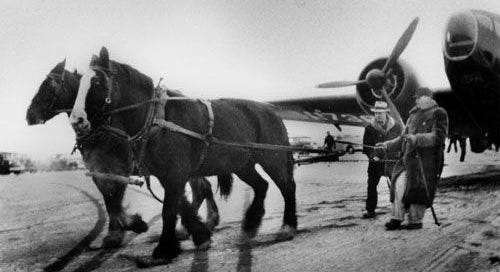Horses on the Payroll in Canada
“Horses on the Payroll” took on a whole new meaning when Canada found itself awaiting purchase aircraft at the same time World War II broke out.
As Robert Kaplan and others often point out, geography has a heavy hand in the fate of countries. And the United States had found itself benefitting from its geographical isolation. During the 1920s and 1930s, the U.S. embraced that isolationism and displayed pacifism to try and remain neutral in an increasingly interconnected world.
In addition to striving for neutrality, the U.S. sought to conduct business – notably delivering arms and aircraft – to other countries. When war was declared in 1939 in Europe, the orders from countries like Great Britain, France, Belgium, and Canada became complex.
The U.S. now found itself providing arms to countries at war. Recognizing the lost perception of neutrality, the U.S. Government took swift action. On November 4, 1939, the Neutrality Act was passed forbidding the delivery by air by U.S. pilots of any aircraft to countries coined ‘belligerent’ – or at war.
A Caveat in the Neutrality Act
It is important to note that the Neutrality Act did not prohibit the delivery of aircraft via sea, road, or rail. This not only minimized the impacts for European countries purchasing American-made aircraft, but it also manifested itself through juicy supply targets for German U-boats stalking the Atlantic shipping lanes.
For Canada, the impacts were much greater. The Royal Canadian Air Force (RCAF) had started receiving deliveries from the Lockheed and Douglas factories in the United States. Of an initial order of around 80 aircraft, including Harvard trainers, Lockheed Hudsons, and Douglas B-18 Digby bombers, the Canadians would receive under 30. Many of the remaining would be diverted to the Royal Air Force (RAF) in Britain.
In dire need of the aircraft, the RCAF could not accept any delays or extra costs associated with dismantling the aircraft and delivering them by road or rail. Then President Franklin D. Roosevelt and his administration began looking for ways to loosen the Neutrality Act restrictions.
A Quick Thinking Solution
While Washington D.C. worked to revise the Neutrality Act, a more prudent solution was devised. Looking for a way to stay within the framework of the law, the idea of a pair of landing fields straddling the U.S./Canada border became a creative solution. It could circumvent the law and more importantly, preserve the delivery of RCAF aircraft.
The factories sourcing the aircraft were in California, so North American Aviation recommended a landing strip near Coutts, Alberta and Sweetgrass, Montana. They also established a strip near Emerson, Manitoba and Pembina, North Dakota. Later on, they would create a third site on the Maine / New Brunswick border.
One stipulation of the Neutrality Act was that the exchange of aircraft across the border required a citizen and could not be to a military agent of the receiving country. However, there was a simple solution for that as well.
Local farmers, with their teams of horses, hitched to the planes and pulled them across the U.S.-Canadian border. Once across the border, the planes were fueled up and sent on the short flight to Winnipeg where they would receive one last look over before heading off to battle.
The Legend of the Cross-Border Landing Strips
As quickly as this ‘wink wink’ plan came together, the cross-border transfer scheme ended. In late summer of 1940, FDR had successfully enacted the Lend Lease Act that loosened restrictions on ‘transactions’ to countries at war.
Nevertheless, if you see the black and white images of powerful horses pulling American-built combat aircraft across an empty field, it is hard not to appreciate the creativity, ingenuity, and swiftness with which a solution was created and executed.
Amidst all the formalities and letters of the law, in a little over a week, the United States and Canada had re-established the flow of aircraft through this swift and simple action. This preserved much needed U.S. support for the RCAF in the early stages of World War II.
Photo Credit: State Historical Society of North Dakota (00709-50)
History of the Hurried
December 25, 1868: President Andrew Johnson grants general amnesty to all parties involved in the Civil War.
December 27, 1927: Josef Stalin consolidated his power in Soviet Russia by expelling rival Leon Trotsky from the Soviet Communist Party.
December 30, 1862: During the American Civil War, the Union ironclad ship USS Monitor sank off Cape Hatteras, North Carolina, during a storm, resulting in the loss of sixteen.




